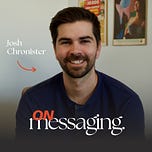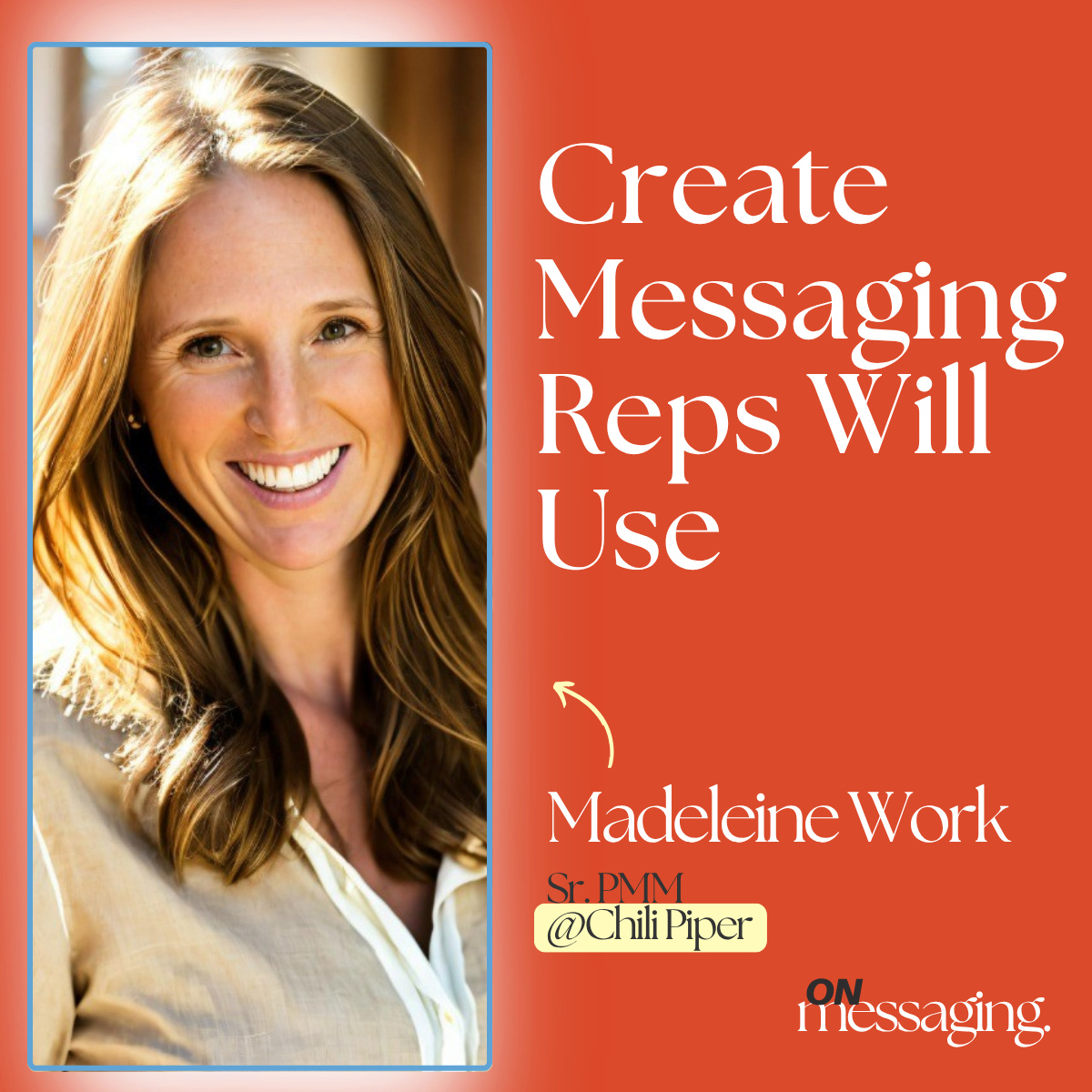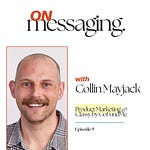Listen now on YouTube, Spotify, and Apple Podcasts!
On the show today, I have Madeleine Work, senior product marketing manager at Chili Piper and now head of marketing at PortPro.
If you know Madeleine or follow her on LinkedIn, you know she’s witty, a great writer and a tremendous voice in the product marketing space.
I really enjoyed this conversation. Madeleine leaves us with very tactical advice on messaging and we share some really good laughs.
During our conversation, you’ll learn:
How to A/B test website messaging
Getting internal buy-in on your messaging
Balancing creativity and clarity in messaging
How to create continuous feedback loops with sales
Why product launches are on going and why you should repeat yourself
And so much more.
Key points from my conversation with Madeleine
1. From content marketing to product marketing — Madeliene’s advice on making the switch
Madeleine didn’t start in product marketing—but not far from it.
She began her career as a content specialist, owning “anything with words,” which meant she touched everything from messaging and sales enablement to blogs and SEO.
When she moved to Chili Piper as a content marketing manager, her boss asked her a simple question one day:
“What marketing work do you actually enjoy?”
Speaking like a true product marketer:
She loved messaging, landing pages, and listening to sales calls to understand target audiences. She wasn’t as excited about SEO, blogging, or managing social.
That single question from her manager helped make the switch.
Instead of waiting for a formal job change, she started volunteering for product marketing–related projects—messaging frameworks, sales enablement materials, launch plans—anything that would stretch her skills.
“Startups are perfect for this,” she says. “There are always more projects than people. If you fill a gap, you can ease your way into product marketing before an official role even opens up.”
2. How to get company-wide buy-in on messaging
Trying to get 100% company-wide buy-in on messaging is nearly impossible—and when you do, it usually leads to watered-down copy no one loves (or remembers).
Instead of chasing consensus, Madeleine tried a unique, “democratized” approach when reworking messaging for an email scheduling product.
Here’s how it worked:
She invited a huge portion of the company—about 60% of employees, most of whom would be end users, to participate.
A mock landing page was shared, and employees were asked to submit H1 ideas across three categories: persona-driven, competitor-driven, and value-driven.
After a week of submissions, everyone voted on their favorites.
The top picks went through a Wynter test and A/B testing on the website with Mutiny.
The winner?
“Less time scheduling, more time selling.”
It was a headline submitted by one of the end users themselves—proving that involving the people closest to the product can lead to messaging that actually resonates.
“When your end users are writing the headlines, you get language that feels natural. It’s how they’d explain the product themselves.”
3. How Madeleine creates platform messaging across multiple products
Managing platform messaging across multiple products is tricky. It’s all too easy to water down the core value until it sounds like every other company in your space.
At Chili Piper, Madeleine Work tackles this by focusing on “the how” rather than just “the what.”
Instead of leaning on vague promises like “drive more pipeline,” the team defined a unifying theme true across all their products:
“Improving conversion across demand points.”
That phrase covers any process that happens between marketing and sales handoff—things like:
Routing leads from gated content,
Enabling immediate meeting bookings after form submissions,
Or helping reps schedule meetings faster during cold calls.
They call this “demand conversion.” Madeleine admits the term might be a little jargony (and still evolving), but it gives the platform messaging a strong, cohesive anchor.
And they don’t shy away from the competition either. Chili Piper’s website directly shows how they stack up against other tools and manual processes—because buyers don’t evaluate products in a vacuum.
“We want to be transparent. Buyers compare tools anyway, so why not help them make an informed decision?”
4. How to balance creativity with clarity in messaging
At Chili Piper, balancing creativity and clarity in messaging comes down to one thing:
Write the way you talk.
The brand has a playful, slightly edgy tone, but Madeleine keeps the copy grounded in natural conversation. That approach communicates value directly and avoids drowning in corporate jargon.
For example, instead of a corporate-sounding headline, they’ll go with something like:
“Lead routing doesn’t have to be a full-time job.”
Madeleine admits her personal LinkedIn posts can sometimes be a little too edgy, but the overall philosophy is clear: if it doesn’t sound human, it won’t land.
“The best messaging comes from really understanding the customer’s mindset and using their exact words or frustrations.”
To do that, she leans heavily on listening to sales calls (via Gong). Those calls often uncover language that customers actually use—phrases like:
“No more complaints about unfair lead distribution.”
That line, pulled straight from a customer pain point, became one of their most effective headlines.
5. Is marketing to other marketers easier or harder?
Marketing to marketers comes with its own set of advantages and headaches.
On the plus side, you often are the persona. That makes it easier to tap into their pains and create content that feels relatable—even funny—because you live their world every day.
But it’s harder in other ways. Marketers behave differently online. They almost never click UTM-tracked links. Instead, they’ll Google your company directly or find you through organic search.
And yet… when you ask them “How did you hear about us?” on a demo form, you get gold.
Marketers write detailed answers. They’ll tell you exactly which podcast episode they heard, which LinkedIn post they saw, and how they followed up by checking out your site.
“They don’t click the links, but they give you incredible qualitative feedback when you ask. Marketers are some of the most engaged and discerning buyers out there.”
6. The process for refining messaging over time, including gathering feedback, testing, and iterating
Refining messaging is never one-and-done.
Madeleine keeps a tight feedback loop with sales and a clear cadence for updates.
The process starts immediately after publishing a new page. It’s shared with the sales team right away, with an open invitation for what Madeleine calls “scathing feedback.”
Sales reps are on the front lines. They see how customers react in real time, so their notes—whether it’s a typo, unclear phrasing, or messaging that just doesn’t land—are addressed quickly.
Beyond those quick fixes, Madeleine follows a structured schedule for bigger revamps:
Twice a year, the team fully overhauls key sections of the website—product pages, competitor pages, and the “demand conversion” page.
Her mentality is simple:
“Ship it, then fix it.”
Perfection isn’t realistic. Launching fast and iterating based on customer and sales feedback leads to stronger messaging than waiting for the “perfect” version.
In our conversation, we cover
00:00 – Teaser: How Madeleine crowdsourced and tested messaging across her company
00:29 – Intro to Madeleine and what you’ll learn in the episode
01:44 – From content to product marketing: how the transition happened
03:24 – What she loved (and didn’t love) about content marketing
06:01 – The challenge of getting 100% messaging buy-in
06:55 – The collaborative H1 test: value, competitor, and persona buckets
08:53 – Running messaging through Wynter and Mutiny
12:21 – The importance of above-the-fold copy and first impressions
14:08 – UI images in messaging: show, don’t tell
15:10 – How Chili Piper defined its platform messaging
15:59 – “Demand conversion”: the phrase they landed on
17:47 – Messaging in a competitive landscape (and naming your competitors)
19:32 – How they brainstormed the phrase “demand conversion”
21:02 – Creativity vs. clarity: writing how you talk
23:44 – “No more complaints about unfair lead distribution”: voice-of-customer in action
25:18 – Marketing to marketers: easier and harder
26:13 – Why marketers don’t click UTM links—but give amazing form responses
28:46 – How Madeleine continuously refines messaging over time
29:53 – Sales feedback loops and scathing voice notes
30:23 – Refresh cadence: product pages, competitor pages, then restart
31:59 – PDF collateral vs. web content: keeping everything updated
33:35 – Launches Madeleine’s proud of (and what she learned)
35:12 – Why no one noticed the chat launch—and how they relaunched it
36:55 – The importance of repetition in product marketing
38:33 – Using Gong to track if messaging is landing with reps
40:04 – What living is all about: being a little uncomfortable
41:28 – Where to find Madeleine and her “Madeleine Love” folder
Connect with Madeleine on LinkedIn: https://www.linkedin.com/in/madeleinework/
Connect with me on LinkedIn: https://www.linkedin.com/in/joshua-chronister/
Listen on Spotify:
Listen on Apple Podcasts:
Follow On Messaging:
Subscribe, like, and share if you’re a product marketer crafting messaging in B2B SaaS. New episodes drop every other week 💛
Created by Josh Chronister
I interview the best product marketers and tech companies who create messaging that resonates with their buyers. Come learn from them, so you can hit ‘Publish’ with confidence.














